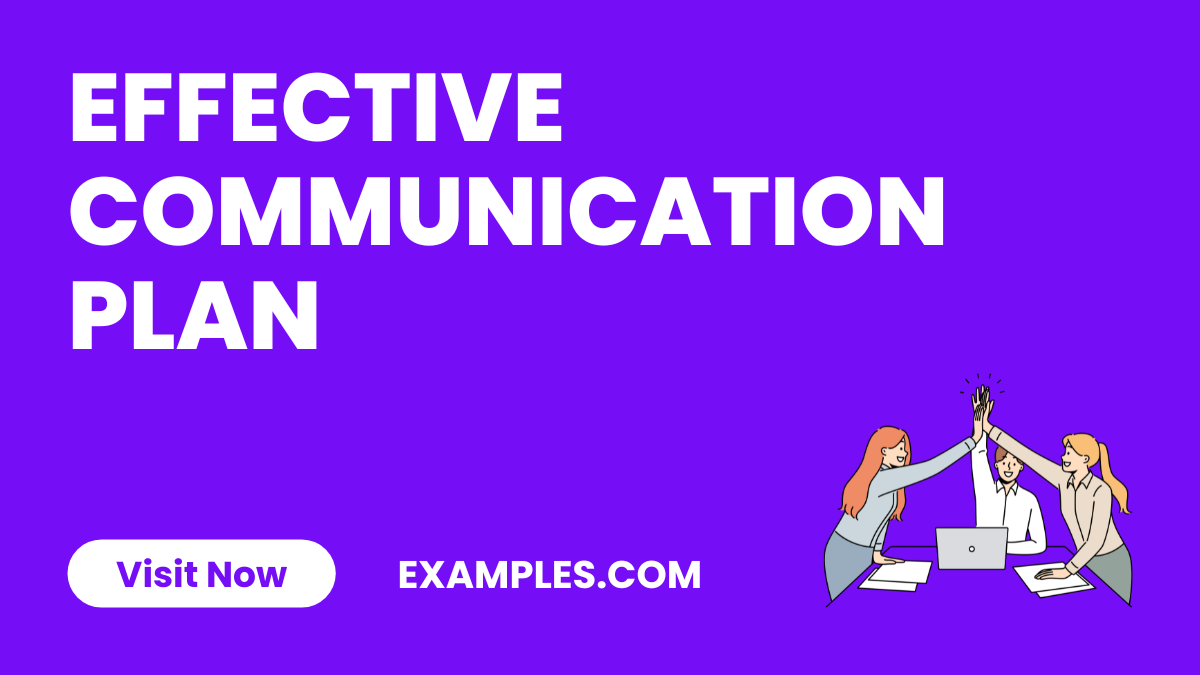5 Effective Communication Plan Examples
Delve into the comprehensive Effective Communication Plan is a valuable resource designed to enhance your communication skills. This guide covers the fundamentals of effective communication strategies, including Communication Examples to illustrate best practices. Whether you’re seeking to improve personal relationships or enhance your professional interactions, this guide offers insights, tactics, and clear communication frameworks to help you become a more adept communicator. Explore the power of strategic messaging and seamless communication in this indispensable resource.
Download Effective Communication Plan Bundle
Effective Communication Plan
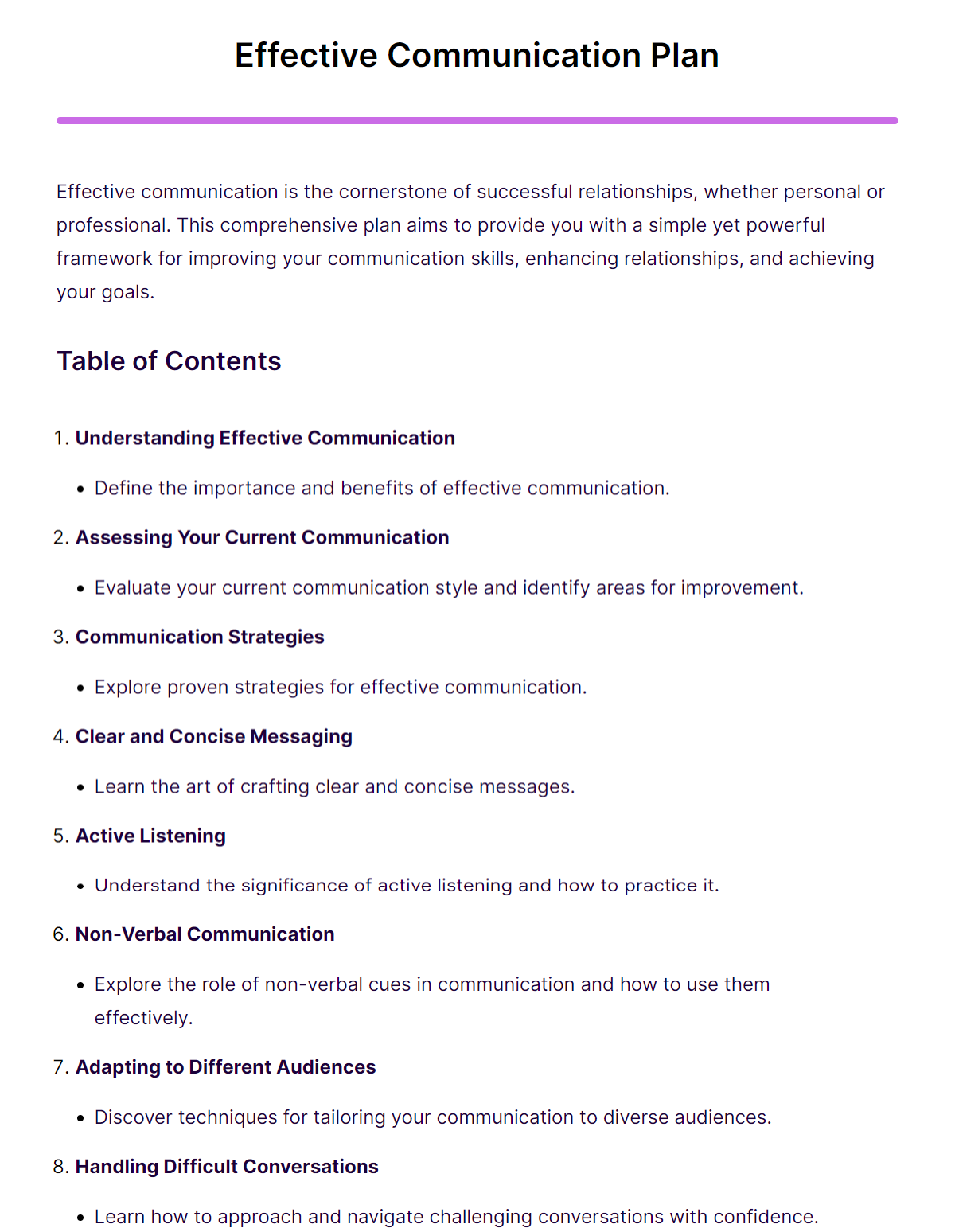
The document outlines a comprehensive Effective Communication Plan, emphasizing the importance of successful personal and professional relationships. It provides a detailed framework for enhancing communication skills, offering strategies for clear messaging, active listening, and adapting to diverse audiences. Additionally, it guides handling difficult conversations, utilizing feedback for improvement, and implementing the plan in various life aspects for better conflict resolution and goal achievement.
Effective Crisis Communication Plan
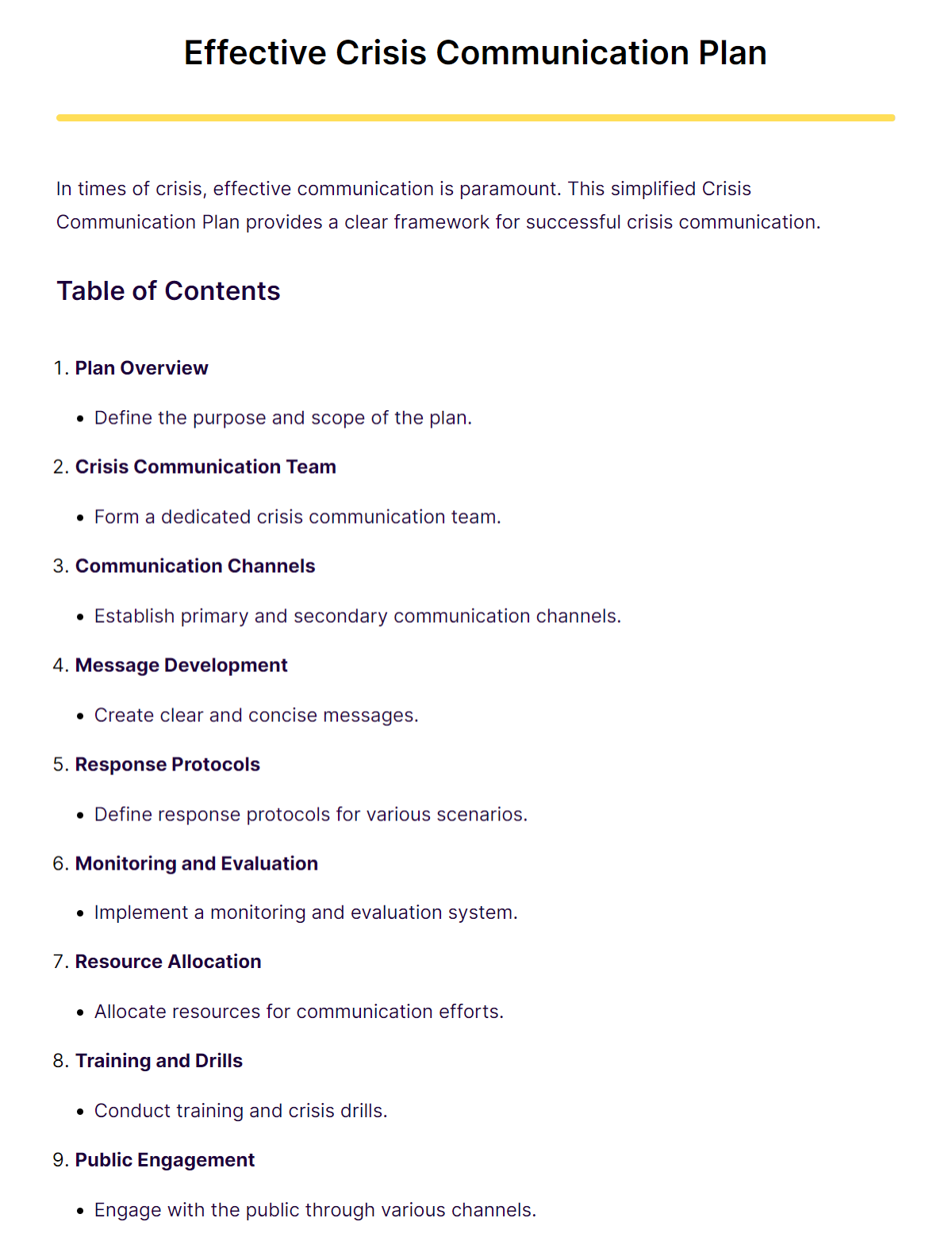
The document titled Effective Crisis Communication Plan is provides a concise yet comprehensive guide for handling communication during crises. It outlines the critical elements of a crisis communication plan, including defining its purpose and scope, forming a dedicated team, establishing communication channels, developing clear messages, setting response protocols, and engaging with the public. It’s a valuable resource for organizations seeking to minimize confusion and maintain trust during challenging times
Effective Project Communication Plan
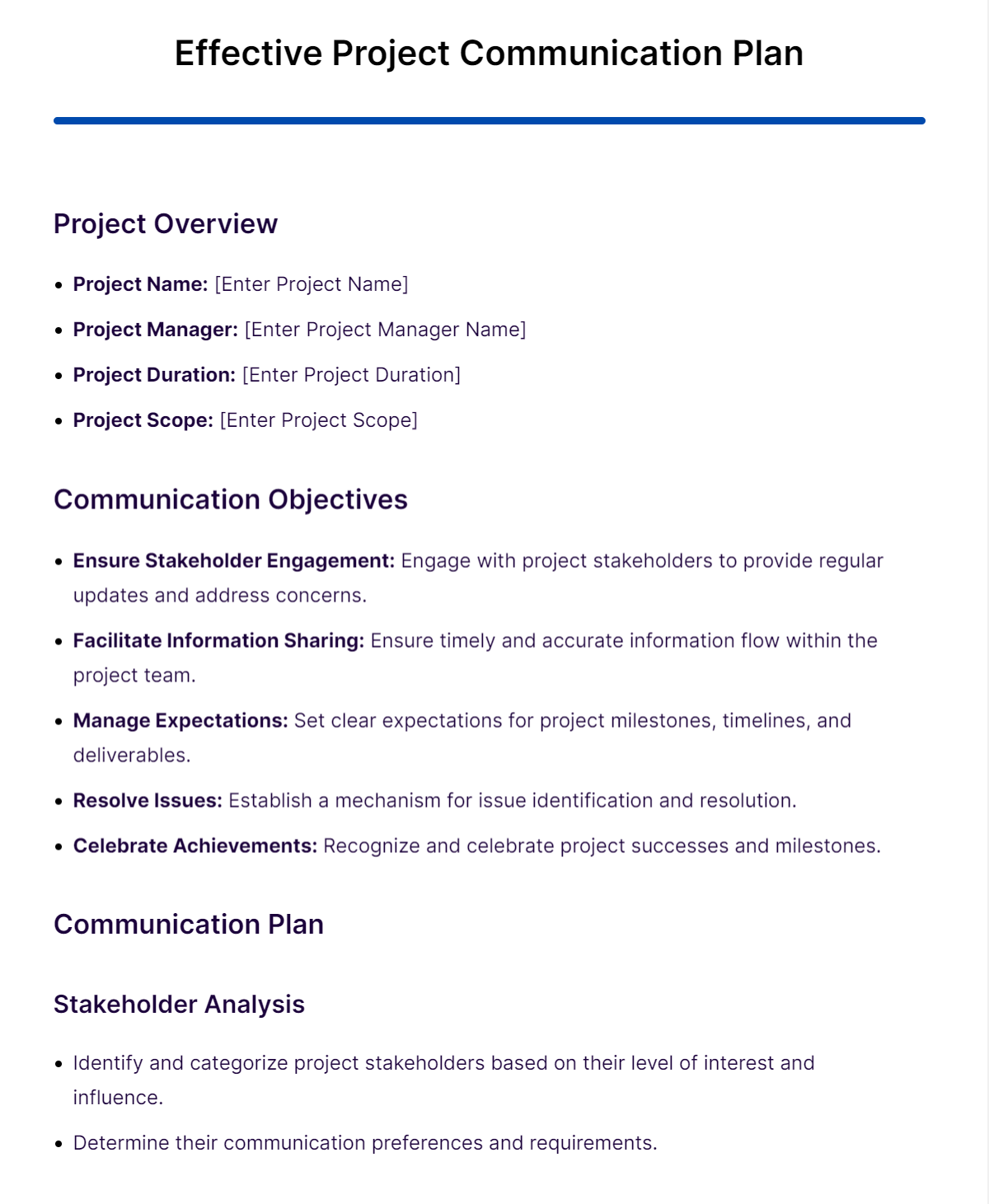
The Effective Project Communication Plan is a comprehensive guide designed to streamline project communication. It addresses various aspects like stakeholder analysis, communication channels, matrices, schedules, issue escalation processes, and feedback mechanisms. The plan emphasizes the importance of clear objectives, tailored messages, and systematic documentation, ensuring all project-related information is communicated efficiently and effectively to relevant stakeholders.
Effective Communication Management Plan

ohioschoolboards.org
DownloadEffective Communication Plan Worksheet
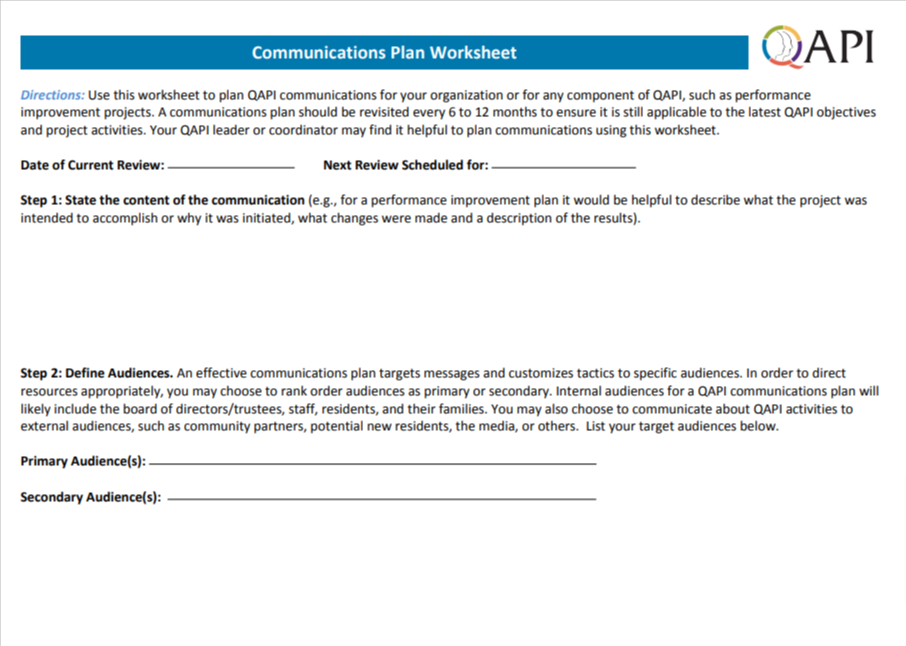
cms.gov
DownloadHow do you Write an Effective Communication Plan?
Crafting an effective communication plan is essential for success in various endeavors. Learn the art of creating clear, strategic, and results-driven communication strategies to achieve your goals.
- Alignment with Goals: Ensure your communication plan aligns with your organization’s overarching goals, promoting synergy and focus in your messaging.
- Stakeholder Engagement: Engage stakeholders actively by defining communication protocols and channels for effective two-way communication.
- Audience Analysis: Conduct thorough audience analysis to tailor your messages to resonate with diverse demographics and preferences.
- Message Consistency: Maintain message consistency across all communication channels to build trust and credibility.
- Crisis Communication: Include protocols for crisis communication, ensuring you can respond effectively during unexpected events.
- Clear Objectives: Define clear communication objectives to measure the success and impact of your strategies.
- Feedback Mechanisms: Implement feedback mechanisms to gather insights and continuously improve your communication plan.
- Resource Allocation: Allocate resources wisely, considering personnel, technology, and budget constraints.
- Monitoring and Evaluation: Establish metrics and regular evaluations to assess the plan’s effectiveness and make necessary adjustments.
- Communication Calendar: Create a communication calendar to ensure timely and consistent messaging aligned with key events and milestones.
What are the Key Components of an Effective Project Communication Plan?
An effective project communication plan is a strategic blueprint vital for ensuring clarity, consistency, and continuity in messages throughout a project’s lifecycle. Key components include clear objectives, stakeholder analysis, information distribution methods, frequency of communication, and feedback mechanisms. Emphasizing these elements enhances collaboration and project success.
- Stakeholder Analysis: Understand who needs what information.
- How to Communicate: “Identify stakeholders’ needs and preferences early in the project.”
- Clear Objectives: Define what the communication aims to achieve.
- How to Communicate: “Communicate objectives in team meetings to align efforts.”
- Defined Channels: Establish how information will be shared.
- How to Communicate: “Use email for formal updates and instant messaging for quick queries.”
- Frequency of Updates: Set regular intervals for communication.
- How to Communicate: “Schedule weekly project status meetings.”
- Feedback Mechanisms: Create avenues for receiving responses.
- How to Communicate: “Encourage team members to provide feedback in meetings.”
- Message Consistency: Ensure the information is coherent across all channels.
- How to Communicate: “Reinforce key messages at every opportunity.”
- Crisis Communication: Prepare for potential issues.
- How to Communicate: “Develop a crisis communication plan to address unexpected challenges.”
- Cultural Sensitivity: Recognize and respect cultural differences.
- How to Communicate: “Tailor messages to be culturally appropriate for all team members.”
- Documentation: Keep records of all communications.
- How to Communicate: “Archive emails and meeting notes systematically.”
- Evaluation and Adaptation: Continuously assess and improve communication strategies.
- How to Communicate: “Review the effectiveness of communication methods regularly and make adjustments as needed.”
What are the Planning Steps of an Effective Communication Plan?
Creating an effective communication plan involves a series of well-defined steps to ensure that your messaging aligns with your goals and reaches the right audience. Here’s a comprehensive guide on the planning steps:
Step 1: Define Objectives and Goals
Start by clarifying the objectives of your communication plan. What do you aim to achieve? Your goals should be specific, measurable, achievable, relevant, and time-bound (SMART).
Step 2: Identify Your Audience
Understand your target audience’s demographics, interests, needs, and communication preferences. Tailor your messages to resonate with them effectively.
Step 3: Craft Key Messages
Create clear, concise, and compelling key messages that align with your objectives. These messages should convey your main points and be easy to understand.
Step 4: Choose Communication Channels
Select the most appropriate communication channels to reach your audience. Consider a mix of online and offline platforms, such as social media, email, print media, or in-person meetings.
Step 5: Develop a Communication Plan
Create a detailed plan that outlines the timing, frequency, and content of your communications. Include a communication calendar to stay organized.
Step 6: Assign Responsibilities
Determine who in your team or organization will be responsible for each aspect of the communication plan, including content creation, distribution, and monitoring.
Step 7: Allocate Resources
Allocate the necessary resources, including budget, personnel, and technology, to support your communication efforts effectively.
Step 8: Create a Feedback Mechanism
Establish feedback mechanisms to gather insights from your audience. This can include surveys, feedback forms, or social media monitoring.
Step 9: Monitor and Measure
Regularly monitor the performance of your communication plan using key performance indicators (KPIs). Evaluate the plan’s effectiveness and make adjustments as needed.
Step 10: Review and Adapt
Periodically review the communication plan to ensure it remains aligned with your objectives and adapts to changing circumstances.
How To Effectively Communicate Your Strategic Plan To Employees?
Effective communication of a strategic plan to employees is essential for aligning the workforce with the company’s vision and goals. This guide focuses on optimizing communication strategies for an “Effective Communication Plan”, ensuring that every team member is informed, engaged, and motivated.
- Clarity in Messaging: Begin by clearly articulating the strategic plan’s objectives, outcomes, and the role of each employee in this vision. Use straightforward language to avoid misunderstandings.
- Utilize Various Communication Channels: Leverage multiple channels like emails, intranet postings, meetings, and video conferences to ensure widespread reach and understanding.
- Interactive Sessions: Host Q&A sessions, workshops, and team meetings to discuss the strategic plan in detail. This encourages dialogue and helps in addressing any concerns or confusion.
- Leadership Involvement: Have leaders at different levels communicate the plan to their respective teams. Leadership endorsement can significantly increase buy-in from employees.
- Feedback Mechanism: Establish channels for employees to provide feedback on the strategic plan. This can help in identifying areas of confusion or resistance and allows for prompt action.
- Consistent Follow-Up: Regularly update employees on the progress of the strategic plan. This maintains the momentum and keeps the plan at the forefront of their daily operations.
- Recognition and Rewards: Acknowledge and reward departments or individuals who effectively align with and contribute to the strategic plan. This can serve as a powerful motivator for others.
- Cultural Sensitivity: Tailor your communication to resonate with the diverse cultural backgrounds of your employees. This fosters an inclusive environment where every voice is valued.
- Training and Support: Provide necessary training and resources to help employees understand and contribute to the strategic plan.
- Transparency: Be transparent about challenges and changes in the strategic plan. This builds trust and credibility among employees.
The article Building a Communication Plan: Every Piece Matters from DINFOS Pavilion delves into creating an effective communication plan strategy through research, action planning, and evaluation. It details a practical scenario at a Navy base, highlighting the importance of understanding the problem, setting clear goals and objectives, identifying key publics, and crafting tailored messages. The plan emphasizes strategies and tactics, budget considerations, and the necessity of regular evaluation to ensure the desired impact. This resource is a comprehensive guide for anyone looking to develop a cohesive and impactful communication plan.
The Community Tool Box’s guide on Developing a Plan for Communication plan emphasizes the importance of a strategic approach to disseminate information effectively. It delves into the essence of communication, the various forms it can take, and the significance of planning to achieve specific goals. The guide outlines the fundamental questions that shape a communication plan, including defining the purpose, audience, message, channels, and distribution methods. It underscores the necessity of ongoing communication efforts, evaluation, and revision to maintain connections with the community and stakeholders.



